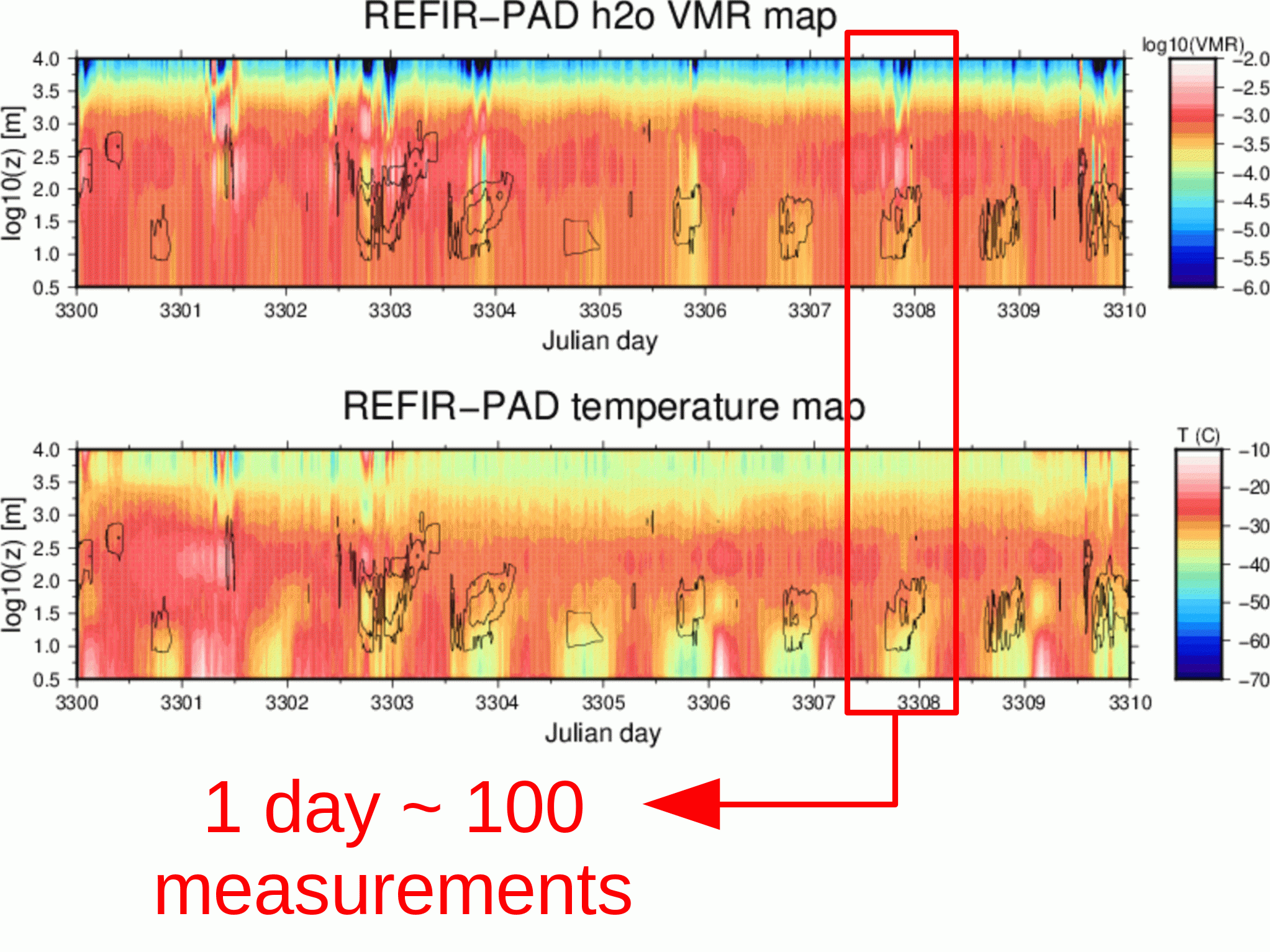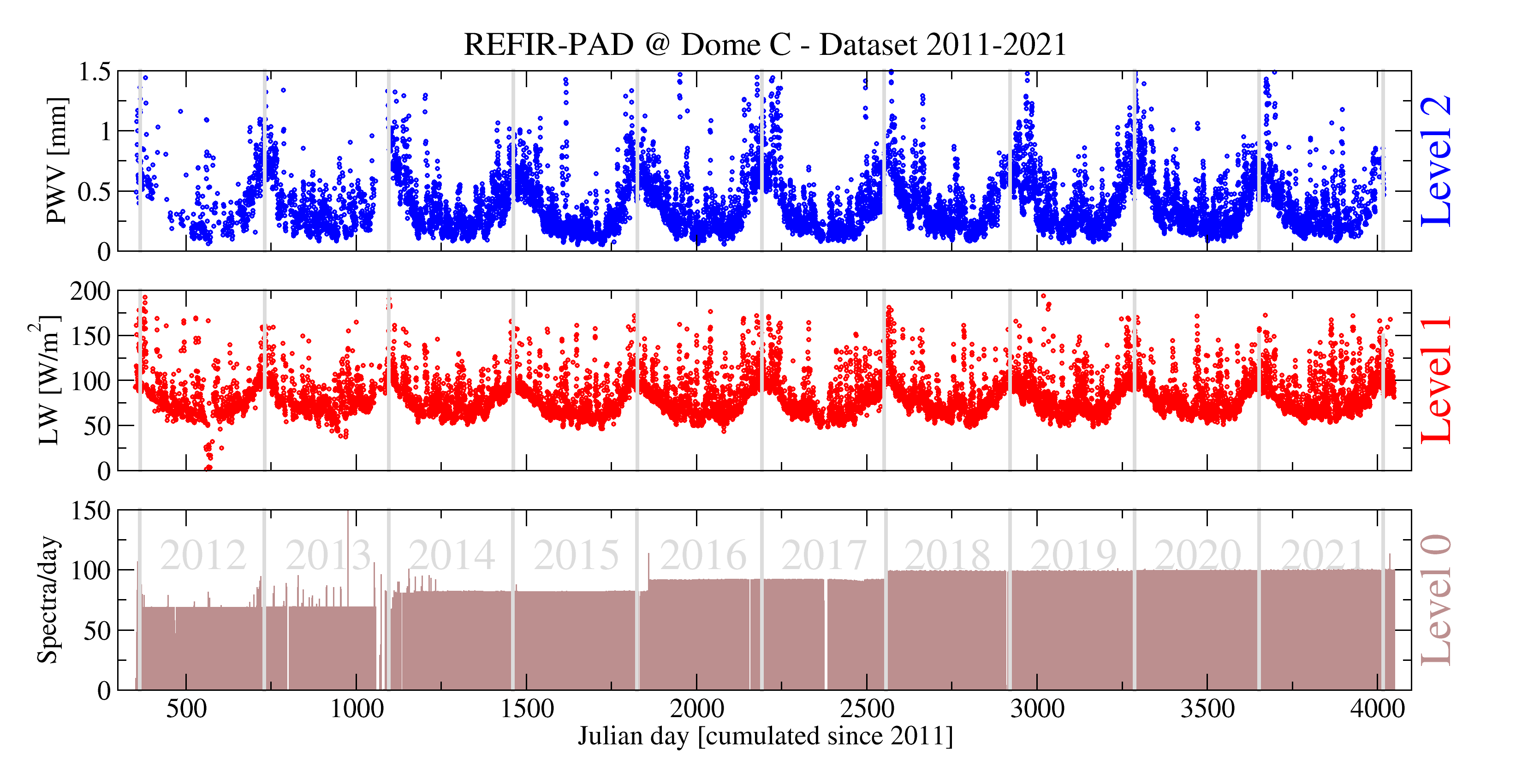- Acronimo
- DOCTOR
- Codice
- 2016/AC3.02
- Anno
- 2016
- Area di ricerca
- Atmospheric sciences
- Tematica specifica di ricerca
- Studio della struttura, della composizione e degli scambi radiativi della troposfera antartica
- Regione di interesse
- Antartide, East Antarctic Plateau, Dome C
- Sito web progetto
- http://refir.fi.ino.it/rtDomeC/
- PI
- Giovanni Bianchini
- Istituzione PI
- Consiglio Nazionale delle Ricerche - Istituto Nazionale di Ottica (CNR-INO)
- Sito web istituzionale
- https://www.ino.cnr.it
- Altre Istituzioni e soggetti coinvolti
- Università di Bologna, Laboratorio Europeo per le Spettroscopie Nonlineari (LENS)
- Consistenza del team ricerca
- Il gruppo di ricerca comprende 5 unità di personale scientifico (ricercatori, primi ricercatori, professori universitari) e 2 unità di personale tecnico.
- Stato progetto
- In corso
- Stazioni principali usate
- Concordia
- Il progetto
Le regioni polari sono particolarmente importanti nei meccanismi climatici. Le calotte polari riflettono gran parte della radiazione solare incidente e hanno un'elevata emissione nell'infrarosso, producendo così un risultato netto di raffreddamento della superficie per emissione di radiazioni.
Il progetto Dome C Tropospheric Observer (DoCTOr) mira a coordinare la strumentazione esistente e quella di nuova installazione in un unico sistema di osservazione il cui obiettivo è quello di effettuare un monitoraggio continuo e a lungo termine delle proprietà dell'atmosfera antartica. Lo scopo di questo monitoraggio è quello di evidenziare sia le tendenze a lungo termine caratteristiche dei fenomeni di cambiamento climatico, sia le perturbazioni a breve scala, queste ultime utili per indagare i meccanismi alla base delle alterazioni climatiche più lente.
Grazie alla continuità con i progetti precedenti, il progetto DoCTOr ha già accumulato una serie temporale di oltre 10 anni, che comprende i profili verticali di temperatura e umidità nei primi km dell'atmosfera (corrispondenti alle regioni dello strato limite e della bassa troposfera), il contenuto totale di vapore acqueo e i valori al suolo misurati da stazioni meteorologiche automatiche. Nel corso del progetto, a questi dati è stata aggiunta la struttura verticale delle nubi nella troposfera.
- Immagini
-
- Motivazione, importanza della ricerca
The importance of the characterization of the troposphere in the Dome C region is related to the peculiar characteristics of the Antarctic plateau, in which Dome C is located. The plateau, in fact, in addition to being the main radiative cooling channel for the Planet, is also characterized by low sensitivity to the phenomenon of so-called "polar amplification," which is the mechanism by which the response of the climate system to certain forcing terms such as increased greenhouse gas concentration, is higher than the average response in the rest of the planet.
This phenomenon is particularly evident in the Arctic, and warming trends of considerable intensity are also measured in western Antarctica, and the Antarctic Peninsula. East Antarctica and, in particular, the plateau region, on the other hand, are much less sensitive, such that in the plateau region trends in ground and lower atmosphere temperatures are very low, bordering on detectable.
One possible explanation for this phenomenon is the characteristic structure of the lower atmosphere on the plateau, which sees for much of the year the presence of a strong thermal inversion layer near the ground. This, together with the presence of infrared-absorbing gases, gives rise to a negative greenhouse effect, that is, the atmospheric layers emit more radiation toward space than they absorb from the ground, increasing the radiative cooling effect.
Consequently, any alterations in the structure of the lower atmosphere such as the attenuation of the inversion layer can have a significant effect on the radiative budget, and for this reason it is important to monitor its presence and evolution over time, with a system that allows both a continuous measurement covering time scales of relevance to climate processes, but also a sufficiently high temporal resolution to be able to detect and characterize phenomena with rapid evolution, such as perturbations and warming events.
- Obiettivi della proposta
The DoCTOr project involves the use of instrumentation already operational at the Concordia station, along with the installation of new instrumentation, to create an autonomous, integrated, and long-term operating system for monitoring structure and radiative mechanisms in the lower troposphere.
The system consists of two main elements: field operational instrumentation, and a data analysis infrastructure in italy.
The observational component, installed at Concordia, has as its main element the Fourier transform spectroradiometer REFIR (Radiation Explorer in the Far-InfraRed), an instrument capable of measuring the radiance emitted from the atmosphere to the surface over a spectral range that includes much of the thermal emission (100-1500 cm-1, or 6.7-100 microns). The measurement is made with sufficient resolution to distinguish the contributions of the main chemical species active in radiative mechanisms, such as carbon dioxide, water vapor, and ozone. The frequency of repetition of measurements, about 12 minutes, is sufficient to resolve rapidly changing phenomena such as the diurnal cycle in summer, or cloud formation during a disturbance.
In the course of the DoCTOr project, the REFIR spectroradiometer has been complemented by a system for measuring the vertical structure of clouds, a product that is complementary to the information contained in the radiance spectra measured by REFIR, and thus very useful for subsequent data analysis.
The data acquired in the field are processed through an inversion code based on state-of-the-art atmospheric radiative transfer models in order to derive the vertical profiles of temperature and humidity, which, in turn, are the basic ingredient for being able to perform the calculation of radiative exchange in the atmosphere and derive the upward and downward radiative fluxes, the heating/cooling coefficients of the various atmospheric layers, and quantify the resulting greenhouse effect.
- Attività svolta e risultati raggiunti
During the course of the DoCTOr project, the integration of the various instruments involved into a single observational system was completed: all instrumentation reports to a single control and data storage system, which also performs the function of preprocessing the measurements in order to send real-time results to Italy. The system includes enough mass storage space to store 3 years of measurements, with RAID1 redundancy, and has a dedicated NTP server based on a GPS receiver, so it is completely autonomous for an indefinite period even in the absence of an Internet connection.
Also during the course of the project, a new sensor, based on the pseudo-random modulation lidar (PRN-lidar) technique, was installed; this new sensor is capable of providing the vertical structure of clouds in the region of interest (boundary layer and lower troposphere) with completely negligible footprint and power consumption compared to the existing instrumentation. The instrument was installed with the transmission-reception optics assembly inside the REFIR spectroradiometer for perfect co-location of measurements.
Regarding data analysis, the entire data set acquired by the REFIR spectroradiometer during the years since its installation at Concordia in December 2011 was completely recalibrated and reprocessed, using the latest version of the analysis codes, to ensure consistency and continuity of the time series of measured atmospheric radiance spectra.
Subsequently, inversion of the atmospheric radiance spectra was performed, obtaining as a result a time-plane tomography of the lower troposphere region in terms of the main parameters needed to describe radiative processes, namely temperature and water vapor.
- Prodotti
R. Rizzi, C. Arosio, T. Maestri, L. Palchetti, G. Bianchini, and M. Del Guasta, “One year of downwelling spectral radiance measurements from 100 to 1400 cm-1 at Dome Concordia: Results in clear conditions”, Journal of Geophysical Research Atmosphere, 121, 10937-10953, doi:10.1002/2016JD025341 (2016).
G. Di Natale, L. Palchetti, G. Bianchini, and M. Del Guasta, “Simultaneous retrieval of water vapour, temperature, and cirrus clouds properties from measurements of far infrared spectral radiance over the Antarctic Plateau”, Atmospheric Measurement Techniques, 10, 825-837, doi:10.5194/amt-10-825-2017 (2017).
G. Bianchini, F. Castagnoli, G. Di Natale, and L. Palchetti, “A Fourier transform spectroradiometer for ground-based remote sensing of the atmospheric downwelling long-wave radiance”, Atmospheric Measurement Techniques, 12, 619-635, doi:10.5194/amt-12-619-2019 (2019).
T. Maestri, C. Arosio, R. Rizzi, L. Palchetti, G. Bianchini, “Antarctic ice cloud identification and properties using downwelling spectral radiance from 100 to 1400 cm-1”, Journal of Geophysical Research Atmospheres, 124, 4761-4781, doi:10.1029/2018JD029205 (2019).
C. Bellisario, H. E. Brindley, S. F. B. Tett, R. Rizzi, G. Di Natale, L. Palchetti, and G. Bianchini, “Can downwelling far-infrared radiances over Antarctica be estimated from mid-infrared information?", Atmospheric Chemistry and Physics, 19, 7927-7937, doi:10.5194/acp-2018-729 (2019).
G. Di Natale, L. Palchetti, G. Bianchini, M. Ridolfi, “The two-stream δ-Eddington approximation to simulate the far infrared Earth spectrum for the simultaneous atmospheric and cloud retrieval”, Journal of Quantitative Spectroscopy and Radiative Transfer, 246, 106927, doi:10.1016/j.jqsrt.2020.106927 (2020).
G. Di Natale, G. Bianchini, M. Del Guasta, M. Ridolfi, T. Maestri, W. Cossich, D. Magurno and L. Palchetti, “Characterization of the Far Infrared Properties and Radiative Forcing of Antarctic Ice and Water Clouds Exploiting the Spectrometer-LiDAR Synergy”, Remote Sensing, 12, 3574, doi:10.3390/rs12213574 (2020).
W. Cossich, T. Maestri, D. Magurno, M. Martinazzo, G. Di Natale, L. Palchetti, G. Bianchini, and M. Del Guasta, “Ice and mixed-phase cloud statistics on the Antarctic Plateau”, Atmospheric Chemistry and Physics, 21, 13811-13833, doi:10.5194/acp-21-13811-2021 (2021).

